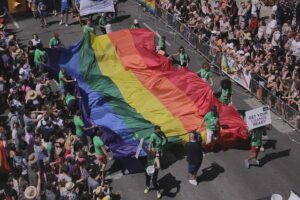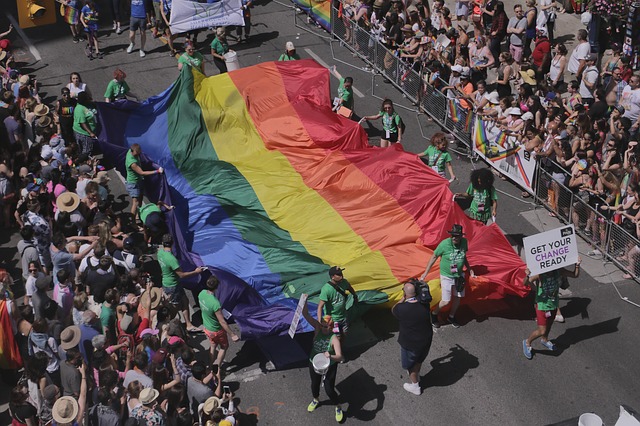Canada’s LGBTQ population is 1 million officialy, Statistics Canada reported

June in Canada and around the world is the month of “Pride” – the pride of the LGBTQ community. The beginning of the present freedom and awareness of the history of the LGBTQ community in Canada began on May 14, 1969 with the decriminalization of homosexuality. Before that, homosexuality was a crime.
For comparison, our Polish-speaking readers can learn that homosexuality has been legal in Poland since 1934. The interwar period (between World War I and II) was a period of rapid development, prosperity and decadence, as well as time of all freedoms. In Germany, homosexuality became legal in 1968 – East Germany and 1969 – West Germany.
But back to Canada – here the milestones in the history of the LGBTQ community are the years 1969 and 1971. 1971 was the year of the first street protests, which over the years turned into marches and then parades. The 1970s were years of symbolic events. In 1977, 50 policemen entered two gay bars and arrested 146 people. In 1978, an amendment to the Immigration Act lifted the ban on immigration of gays to Canada. In June 1979, the first Pride March took place in Montreal. Operation Soap was the culmination of 1981. Police entered gay bathhouses and dragged over 300 naked people into the streets to humiliate them, then arrested them. The event mobilized the Toronto LGBTQ community to fight for tolerance and equality. It took 50 years for the public awareness of equality and tolerance in Canada to reach its current level.
Currently in Canada, on the occasion of Pride Toronto, throughout the month people celebrate their freedom, or rather … the normal existence of the family, everybody, relatives, acquaintances and friends as well as the members of the LGBTQ community themselves. There is no such freedom and tolerance in Canada today in any other country in the world. Therefore, we are at the forefront of countries where people live the best life.
Let us remember that all freedoms once obtained do not last forever. You should take care of them and cultivate them, remembering about history, because history likes to repeat itself.
The release of official statistics by Statistics Canada confirming that Canada is currently home to approximately one million people who identify as members of the LGBTQ community is an incredible recognition of Pride month by the state.
According to the Statistics Canada information, people under 25 are an extremely significant group in this community.
Data collected by Statistics Canada on this matter show that the LGBTQ community in Canada is strongly represented by younger people.
About 30% of LGBTQ Canadians are between the age of 15-24. That is, in the age group that represents only 14% of the non-LGBTQ community. Only 7% of Canada’s LGBTQ community is 65 or older.
Statistics Canada’s report acknowledged a series of momentous developments and legal changes that have affected LGBTQ Canadians’ lives since the early 2000s, including legalization of same-sex marriage and new safeguards for gender identity and expression included in the Canadian Human Rights Act. Canada is ahead of many Western countries in this respect.
Statistics Canada says policy changes have contributed to an increase in the number of same-sex marriages. From 2006 to 2016, the number of same-sex marriages in Canada increased by 60.7%.
Hate crimes unfortunately have an increasing trend. Statistics Canada report also cites threats faced by LGBTQ Canadians – such as the recent rise in hate crimes against people based on their sexual orientation.
In 2019, the police reported 263 such incidents, a 41% increase over the previous year and the highest figure since 2009.
Canada’s LGBTQ community may also have experienced greater economic hardship during the COVID-19 pandemic than non-LGBTQ people, the report said.
People of ages 15-24 experienced the greatest number of job losses of all groups during the pandemic. Since this group is such a large proportion of the LGBTQ population, “it is likely that Canadians [LGBTQ] may be disproportionately affected by losing their jobs during a pandemic”, the report says.
People who identify as LGTBQ also have lower average annual incomes than non-LGBTQ Canadians – $ 39,000 versus $ 58,000. This discrepancy can be explained in part by the fact that the LGBTQ population includes a large number of young people who are usually not well paid.
The 2021 census for the first time asked for the “gender” of respondents in addition to asking about their gender at birth, which may help determine the number of Canadians who are transgender.
June in Canada and worldwide is the month of Pride, getting information and becoming more aware of the reality of our relatives, acquaintances and friends of members of the LGBTQ community. June allows us to become aware of the facts that have had and indirectly influenced also our lives, relationships, as well as our future and the future of our loved ones, who are part of the LGBTQ community – our families and circles of acquaintances.
Pic from pixabay.com



